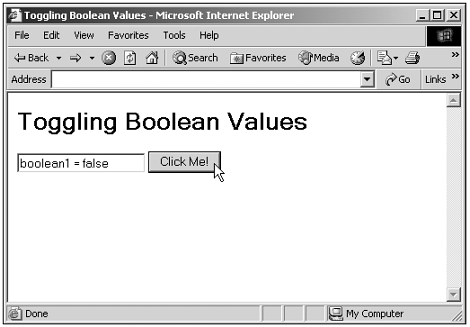Using the Boolean Object
Using the Boolean ObjectYou can create Boolean objects with the Boolean constructor, passing a value of true or false to initialize the object, like this: var boolean1 = new Boolean(true) You can then assign new true or false values to the Boolean object: var boolean1 = new Boolean(true) boolean1 = false Here's an example. In this case, I'll create a new Boolean object and toggle it between true and false when the user clicks a button using the JavaScript not operator, ! (see Table 2.3 and the section "Logical Operators" in Chapter 2, "The JavaScript Language: Data, Operators, and Branching," for more on the ! operator), which flips the logical sense of its argument: var boolean1 = new Boolean(true) function toggler() { document.form1.text1.value = "boolean1 = " + boolean1.valueOf() boolean1 = !boolean1 } Here's what this code looks like in the full example: (Listing 19-05.html on the web site)<HTML> <HEAD> <TITLE> Toggling Boolean Values </TITLE> <SCRIPT LANGUAGE="JavaScript"> <!-- var boolean1 = new Boolean(true) function toggler() { document.form1.text1.value = "boolean1 = " + boolean1.valueOf() boolean1 You can see the results in Figure 19.5, where the value of the Boolean variable flips logical sense from true to false and back again each time you click the button. Figure 19.5. Toggling a Boolean object's logical value. |
